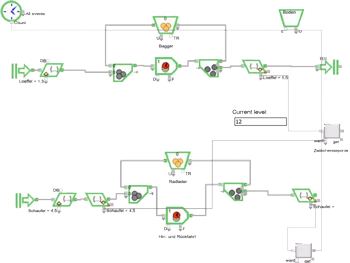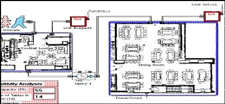 For decades, ExtendSim has helped prepare students for skills they need for today's technology-driven workforce. A small handful of examples of how ExtendSim is empowering students are showcased here.
For decades, ExtendSim has helped prepare students for skills they need for today's technology-driven workforce. A small handful of examples of how ExtendSim is empowering students are showcased here.
START researchers participating in STEM outreach invited 60 high school women from around the country to get a glimpse of some of the on-the-job problems they could face as engineers. Faced with hypothetical crisis situations, students were challenged to build a resilient interdependent hospital that would fare well during a crisis situation. ExtendSim played a key role in helping students understand how a mass exit from a building would impact their hospital’s capabilities.
Entrepreneurial Design for Extreme Affordability, an initiative at the Hasso Plattner Institute of Design, involves graduate students from all seven schools at Stanford University designing comprehensive solutions to challenges faced by the world's poor.  Multidisciplinary student teams work to create innovations that lie at the intersection of business, technology, and human values. The final deliverable is a product or service framed in a comprehensive implementation plan including the business model, the technical innovations, the cultural rationale, and the appropriate next steps. ExtendSim has been utilized in many projects for this course.
Multidisciplinary student teams work to create innovations that lie at the intersection of business, technology, and human values. The final deliverable is a product or service framed in a comprehensive implementation plan including the business model, the technical innovations, the cultural rationale, and the appropriate next steps. ExtendSim has been utilized in many projects for this course.
Improvement
Initiatives
Students in the ExtendSim Adopter program at Benedictine University wanted to evaluate alternative evacuation scenarios during the busiest time of day from the only building opened 24 hours on Benedictine University’s campus. Using ExtendSim,they developed an interactive visual model to compare against the current evacuation plan.

Education &
Training
The Naval Postgraduate School uses ExtendSim to educate and train students on the value of modeling and simulation for military use. It's being used for acquisition of supplies, risk assessment, mission analysis, PTSD healthcare delivery, UAV swarm risk assessment, and more.
Other Examples of ExtendSim Use in Higher Education
- Simulation benefits and concepts being taught to business, engineering, science, etc. students.
- Encouraging students to experiment with ideas, projects, and skills.
- Illustration of concepts.
- Use of simulation-and case-based, active-and self-learning models for understanding and applying Six Sigma principles and tools.
 Professor Robert Batt has been using ExtendSim to teach basic queueing principles to MBA and undergrad students in the Wisconsin School of Business at the Unviersity of Wisconsin - Madison for more than 5 years. At the Production & Operations Management Society Annual Conference in May of 2018, he shared some highlights (and lowlights) from his experiences teaching Service Operations Management to conference attendees. He touched on topics such as favorite cases, in-class exercises, and using ExtendSim simulation software in the classroom.
Professor Robert Batt has been using ExtendSim to teach basic queueing principles to MBA and undergrad students in the Wisconsin School of Business at the Unviersity of Wisconsin - Madison for more than 5 years. At the Production & Operations Management Society Annual Conference in May of 2018, he shared some highlights (and lowlights) from his experiences teaching Service Operations Management to conference attendees. He touched on topics such as favorite cases, in-class exercises, and using ExtendSim simulation software in the classroom.- Chemical process simulation and optimization.
- Visualization of the calculation of income and expenses and construction of financial statements.
- Teaching post graduate students how to model an irrigation reservoir and associated cultivation area for sustainable water management. Student learn to identify important physical properties and water management techniques and practices for irrigation system design, planning, and operation.
- The Tippie Analytics Cooperative at the University of Iowa works with national and international brands to creatively solve some of the most challenging problems facing business today. Clients come from nearly every industry vertical and represent organizations of all sizes. In one of the more recent projects, Patient flow and optimization - University of Iowa Hospitals and Clinics, students from the Tippie Analytics Cooperative used ExtendSim wiht 2 other tools to corral massive amounts of patient encounter data to reveal bottlenecks and opportunities as patients arrive and flow through the multiple engagements that constitute an appointment. Insights provided by the students help UIHC improve the patient experience by driving operational efficiencies, optimizing staffing, and streamlining patient visits.
 Over the last 2 decades, the School of Engineering at the Zurich University of Applied Sciences has been using ExtendSim to teach simulation concepts to its students in a variety of courses:
Over the last 2 decades, the School of Engineering at the Zurich University of Applied Sciences has been using ExtendSim to teach simulation concepts to its students in a variety of courses:
- Simulation of Business Processes • The goal of this course is for students to learn the basic concepts of discrete event simulation then apply these concepts to practical problems. Each week, student teams complete short simulation projects such as the modeling of:
- Back-office of an insurance company
- Job shop manufacturing
- Scheduling rules
- Auto repair facility
- Buffer optimization in a Kanban system
- By course completion, students are able to create quite elaborate models and use most of the functionality of ExtendSim.
- Simulation in Retail and Logistics • A brief 2.5 day course designed not to make students professional simulation experts, but rather give them a hands-on experience about what is possible with simulation and how the general approach to modeling works. During the course, students work with different models, including a blood donation center, ski-lift operations, and a manufacturing scheduling problem. For this course, the best aspect of using ExtendSim is its ability to build models by dragging & dropping blocks from libraries, without the need of programming. Thus, students with little or no programming experience are able to familiarize themselves with simulation.
- Traffic System Operation • Course focuses on the development and use of methods to analyze, evaluate and optimize traffic systems via rail, road, air, and movement of pedestrians and goods. Methods taughter are quantitative and range from the collection and statistical analysis of traffic data to the modeling and simulation of traffic systems to the development of indicators for system evaluation. In addition to coursework, many ZHAW students have selected ExtendSim to assist in the Masters Theses.
- Simulation of Business Processes • The goal of this course is for students to learn the basic concepts of discrete event simulation then apply these concepts to practical problems. Each week, student teams complete short simulation projects such as the modeling of:
 In the Spring of 2019, Benedictine University students Nicole Jenson and Samantha Plezbert presented a paper at the University's URSA (Undergraduate Research, Scholarship, and Arts) Conference titled "Dog Grooming Simulation Model Using ExtendSim". Using ExtendSim, students simulated a typical dog grooming salon business cycle by breaking down the logistical sequence of bringing a dog to the groomer, selecting the requested services, boarding the dog, and then picking up the dog. The model takes into consideration employees’ schedules, compensation, varying dog breed sizes, and their associated service times in addition to other aspects.
In the Spring of 2019, Benedictine University students Nicole Jenson and Samantha Plezbert presented a paper at the University's URSA (Undergraduate Research, Scholarship, and Arts) Conference titled "Dog Grooming Simulation Model Using ExtendSim". Using ExtendSim, students simulated a typical dog grooming salon business cycle by breaking down the logistical sequence of bringing a dog to the groomer, selecting the requested services, boarding the dog, and then picking up the dog. The model takes into consideration employees’ schedules, compensation, varying dog breed sizes, and their associated service times in addition to other aspects.- In 2018, Benedictine University students Maria Eugenia Chong and Paulina Piasecki presented a paper at the URSA Conference titled "Making Advising Great Again: Examining the Advising Process in the Daniel L. Goodwin College of Business at Benedictine University Using ExtendSim". These student workers at the Undergraduate College of Business Department observed that there was a lack of coherency, across department faculty and staff, in the overall way students were being encouraged to sign up for an appointment with their advisor. This added to the stress faculty and staff were already experiencing with their heavy teaching loads. Students felt unorganized and distressed when attempting to create their schedules and meet graduation requirements. Students used ExtendSim to create a model that enables both faculty and students to have a seamless advising experience.
- In addition to paper on advising at Benedictine, another group of students, Anjana Rao, Adam Garza, Bennita Drain, and Mohammad Taqvi tackled “Modeling a Benedictine University Graduation Ceremony Using ExtendSim”. Recognizing that a graduation ceremony is the epitome of moving towards a successful future and is full of excitement and joy, they determined the time to complete the event was tedious. Working with ExtendSim, students simulated an ideal graduation ceremony, cutting time and wasteful pockets of opportunity enabling the opportunity to allow a graduate's family and friends a more enjoyable and time-worthy ceremony.
 At this same conference, another team of undergraduate students, Zach Suhsen, Patrick Wallenberg, Dustin Sullens, and Isaiah Allen, analyzed the sales process of ABC Supply Co. Inc., the United States’ largest roofing material supply company. Beginning with a flow chart of the sales process for roofing materials such as roofing shingles, shingle accessories, base layers, and roofing accessories the students mapped the flow of products go in and out of the company’s facility and warehouse along with the delivery by the driver. Using ExtendSim, they converted the flow chart of the sales process into a model to better understand the process and try to improvethe flow and time of the ABC roofing supply process.
At this same conference, another team of undergraduate students, Zach Suhsen, Patrick Wallenberg, Dustin Sullens, and Isaiah Allen, analyzed the sales process of ABC Supply Co. Inc., the United States’ largest roofing material supply company. Beginning with a flow chart of the sales process for roofing materials such as roofing shingles, shingle accessories, base layers, and roofing accessories the students mapped the flow of products go in and out of the company’s facility and warehouse along with the delivery by the driver. Using ExtendSim, they converted the flow chart of the sales process into a model to better understand the process and try to improvethe flow and time of the ABC roofing supply process.- In 2016, Benedictine University students, G. Ciuksyte, P. Courteau, D. Kersey, and J. Mueller modeled the current state of the freshmen admissions process at Benedictine University. Using approximate statistics from the Benedictine University Admissions Department as well as statistics from the Benedictine University’s Admissions website, students created an accurate model of the current-state admission process at Benedictine University. The model helped identify issues and inefficiencies in the process that slowed down the system. With these findings, students will be able to create an efficient and effective future-state model to make improvements on the system that could then be applied to the actual process used by the Benedictine Admissions team.
- In another project at Benedictine, students B. Brown, L. Lopez, and B. Riva used ExtendSim to model a failing car wash, then remodeled it to make it sustainable. Since 2011, the St. Charles, Illinois car wash was experiencing a steady decline in profits. Students modeled the car wash process and all of its activities, including staffing levels with waiting lines associated with them. Improvements suggested by the model using existing data offered a more efficient car wash process and reflected more revenue going forward.
What Educators are saying about ExtendSim

George Washington University
Engineering Management and Systems Engineering Department
Jim Harris, D.Sc.
"The project was an undefined, open-ended project in which they had three weeks to do research, learn ExtendSim, generate data, perform analysis, and write a short report about the project, etc. All the students learned ExtendSim in this short period of time with little guidance from me... I was quite impressed with each model developed by the three teams of the class... Overall the class liked ExtendSim... The one observation I made was that students who I thought did not understand the material very well, really came alive as a result of this project."

Universität Bonn
Supply chain management, Business Administration, Information Systems
Robert Reiche, Dr.-Ing.
"For research, modelling and discussing - and the visualization of results - it is one of the best simulation programs! I used ExtendSim last semester in a seminar for explaining the different possible outcomes of an scenario, the bullwhip effect and coordination of distribution. All three lectures went pretty well and the students liked the animation and the diagrams."

Naval Postgraduate School
Dave Olwell
"I’ve been using ExtendSim products in my classes since 2002 – and I appreciate your continuing support."

University of Moratuwa
UNESCO Madanjeet Singh Center for South Asia Water Management
Professor N.T.S. Wijesekera
"Post graduate students are impressed by the use of advanced modelling tools for our teaching in the Masters of Water Resources Engineering Program. This enhances the status of our University."
Established Collaborations & Programs Using ExtendSim
Faculty of Architecture and Civil Engineering
Specialisation in Construction Management
 As part of resource and production planning for a construction company, students obtaining a Masters in Civil Engineering create an event-oriented, stochastic IT model and simulate various virtual operating states optimizing resources to determine the most cost effective solution. As a result, the connections between resource planning, costs, and time are shown in an almost playful way. Hochschule Augsburg is a member of the ExtendSim Adopter program.
As part of resource and production planning for a construction company, students obtaining a Masters in Civil Engineering create an event-oriented, stochastic IT model and simulate various virtual operating states optimizing resources to determine the most cost effective solution. As a result, the connections between resource planning, costs, and time are shown in an almost playful way. Hochschule Augsburg is a member of the ExtendSim Adopter program.
MBA and Sloan Elective Courses: Operations, Information, and Technology
OIT 530 Advanced Modeling Seminar
The Stanford Graduate School of Business trains general managers themselves to model complex and uncertain business situations. Stanford offers seminars that consist of hands-on experience with advanced applications for modeling situations that include both uncertainty and discontinuous change. These situations often are called "ill-behaved" because they defeat the traditional tools of analysis. For example, financial spreadsheet models involving discontinuous change, such as winning an auction or unexpectedly altering a production process or marketing campaign (so-called "black swan" events), may arise in business projections, but actual models of such events are rarely, if ever, considered for optimization under uncertainty. As another example, the Operations formulas used to estimate throughput times in models involving congestion and delay often cannot be applied to systems that include unexpected service interruptions or complex routing of items (e.g., modern hospitals). ExtendSim is used to model operational situations in services and manufacturing, with an emphasis on dealing with congestion and delay in complex settings.
 A comprehensive middle school and high school environmental education program coupled with support from the National Science Foundation and Ann Russell at Iowa State University created an ExtendSim model simulating the effects of rainforest deforestation and agriculture (planting pasture crops) on the amount of CO2 in the atmosphere and on animals living in the rainforest. Hence, the Rainforest Simulation Model was born.
A comprehensive middle school and high school environmental education program coupled with support from the National Science Foundation and Ann Russell at Iowa State University created an ExtendSim model simulating the effects of rainforest deforestation and agriculture (planting pasture crops) on the amount of CO2 in the atmosphere and on animals living in the rainforest. Hence, the Rainforest Simulation Model was born.
The Rainforest Simulation Model makes a tropical rain forest come alive as carbon from the air flows through it! Designed for users with no previous modeling experience, this model allows users to delve into "What if?" sorts of questions about factors that limit forest production and the effects of land-use change on carbon cycling and global warming.
Krannert School of Management
An MBA class project at Purdue University's Krannert School of Management has enabled a medical clinic to serve 37% more patients each day. Faculty and students applied factory management techniques to the clinic ultimately improving their productivity and quality of service.
Operations Management in the McDonough School of Business
Professor Ricardo Ernst and Professor Glen Schmidt of Georgetown whet their students' appetites for Operations Management by beginning their core courses with the Benihana case study (HBS 9-673-057).
 Although originally written in 1972, Benihana remains one of the most popular Harvard Business School cases. The case captivates students because it brings operations to life in a familiar setting; that of a teppanyaki-style restaurant.
Although originally written in 1972, Benihana remains one of the most popular Harvard Business School cases. The case captivates students because it brings operations to life in a familiar setting; that of a teppanyaki-style restaurant.
The Benihana simulation models an evening at Benihana's West 52nd Street restaurant. In addition to emulating customer flow patterns and dinner choices, the ExtendSim model incorporates a sensitivity analysis feature that enables the user to examine the impact of altering the restaurant's capacity, and the bar capacity.
Harvard Business School created a series of case studies to introduce students to the concept of simulation for the analysis of business decisions. These case studies demonstrate how a business analyst has a means of experimenting with a system and its possible future environments without disrupting the present situation.
School of Chemistry
Department of Chemical Technology and Industrial Chemistry Laboratory General and Inorganic Chemical Technology
Dr. Georgios Gallios, Associate Professor
Dr. Georgios Gallios, Associate Professor in the Department of Chemical Technology and Industrial Chemistry Laboratory General and Inorganic Chemical Technology in the School of Chemisty at Aristotle University of Thessaloniki, uses ExtendSim as an aid in teaching simulation and optimization of chemical processes in postgraduate courses.
Science and Policy Integration for Coastal Assessment
Initially set up as a four year project by the European Union. 54 partner institutes in 21 countries are using ExtendSim to study 18 coastal sites in the EU project SPICOSA. This project has assisted Europe in its goal of achieving Sustainable Development by developing and testing a conceptual methodological framework for transition in coastal zones. The SPICOSA initiative originates from the fact that coastal systems are under increasing human pressure and policy has not been able to respond properly to the resulting negative impacts on ecological, social and economic systems.
SPICOSA´s overall aim is to develop a self-evolving, holistic research approach and support tools for the assessment of policy options for sustainable management through a balanced consideration of the ecological, social and economic aspects of Coastal Zone Systems (Integrated Coastal Zone Management).
All 18 study sites of SPICOSA are now well underway with the design of their ExtendSIM® models to describe a variety of coastal processes ranging from eutrophication, fisheries, and beach attractiveness to clam culture. A generic model library is a complete set of reusable model components which can be used to (re)build coastal models for new study areas, not much unlike the well-known Lego bricks.
The population of such a model library is one of the key challenges of the project and serves several purposes:
- Existing models are easier to expand or maintain.
- New models are easier to build.
- Quick exchange of models within the scientific community.
- Avoidance of unnecessary modelling (not “reinventing the wheel”).
he principles of generic modelling have been elaborated during the SPICOSA Cluster Workshops.
 For more information about ExtendSim use and its history in SPICOSA projects, read the series of newsletters on the SPICOSA site.
For more information about ExtendSim use and its history in SPICOSA projects, read the series of newsletters on the SPICOSA site.






 Model FAQs...
Model FAQs...



